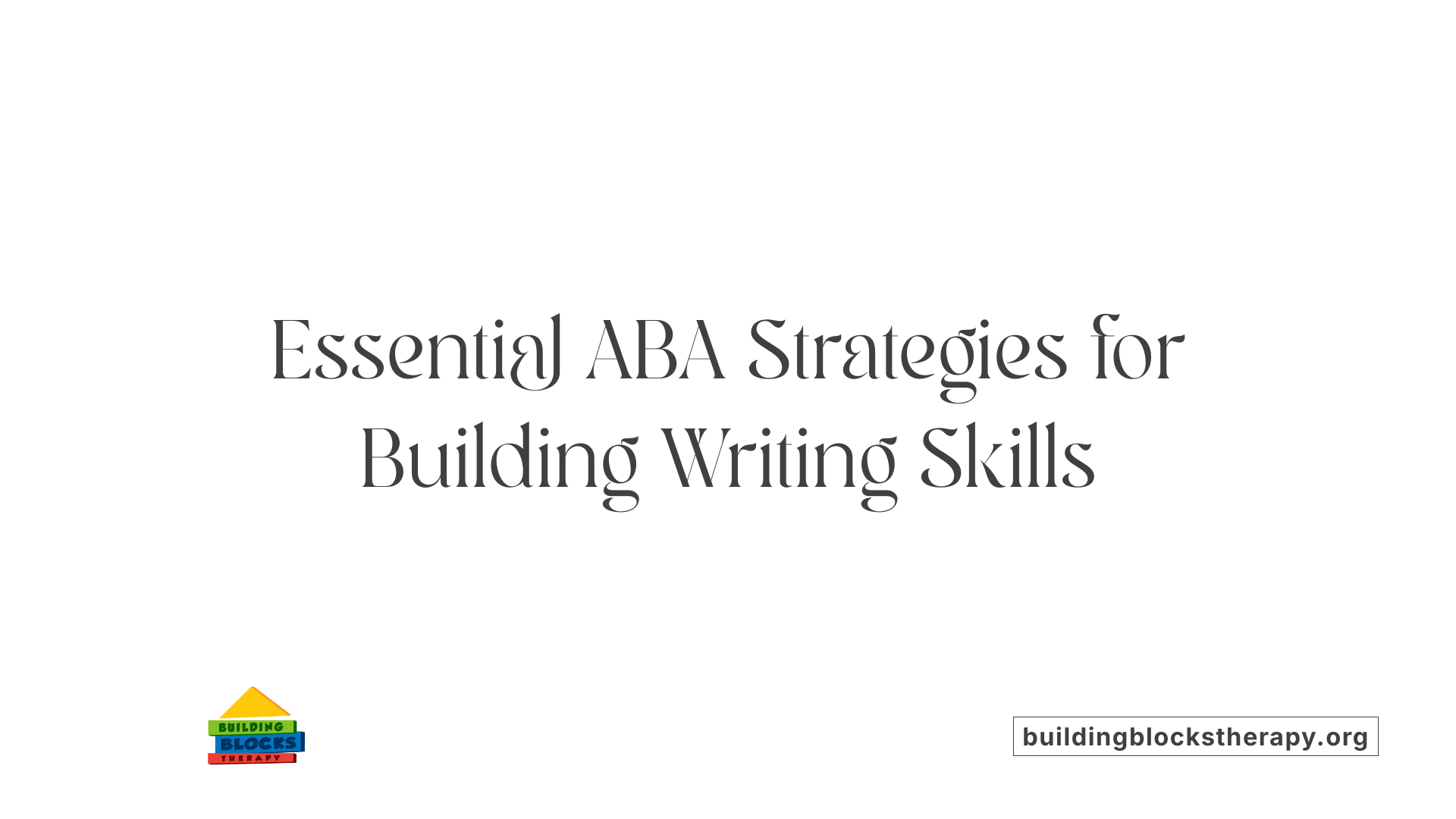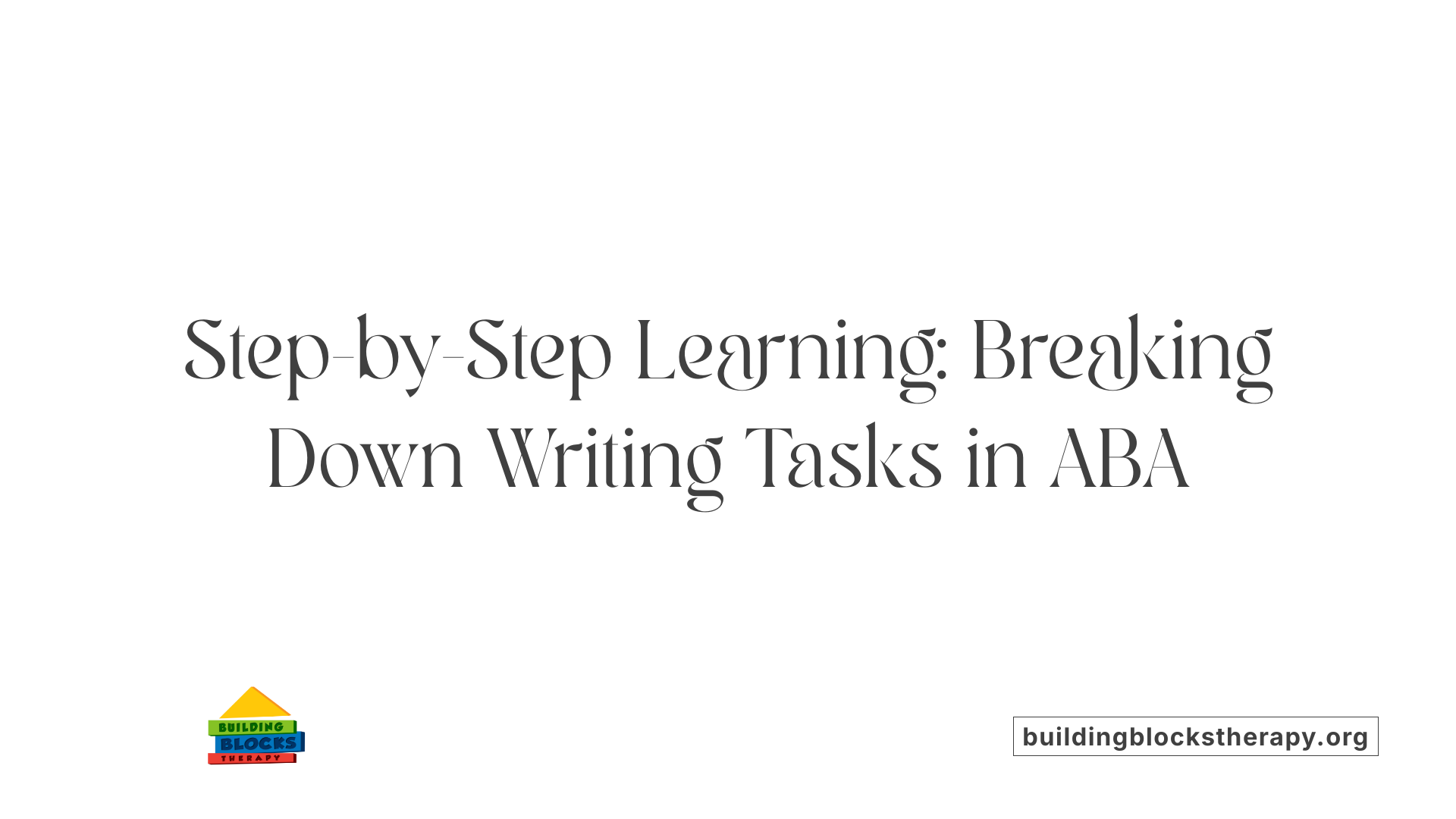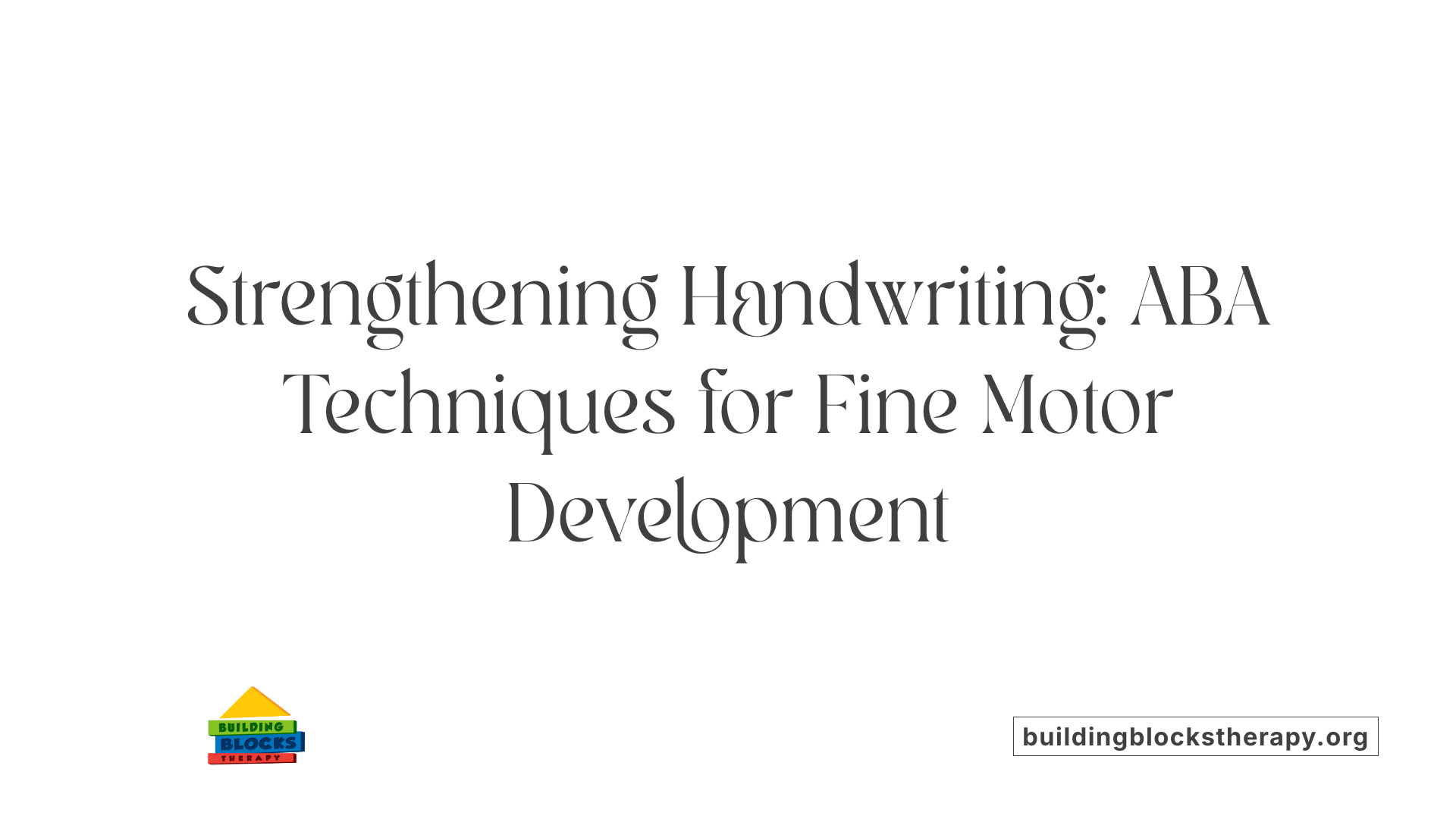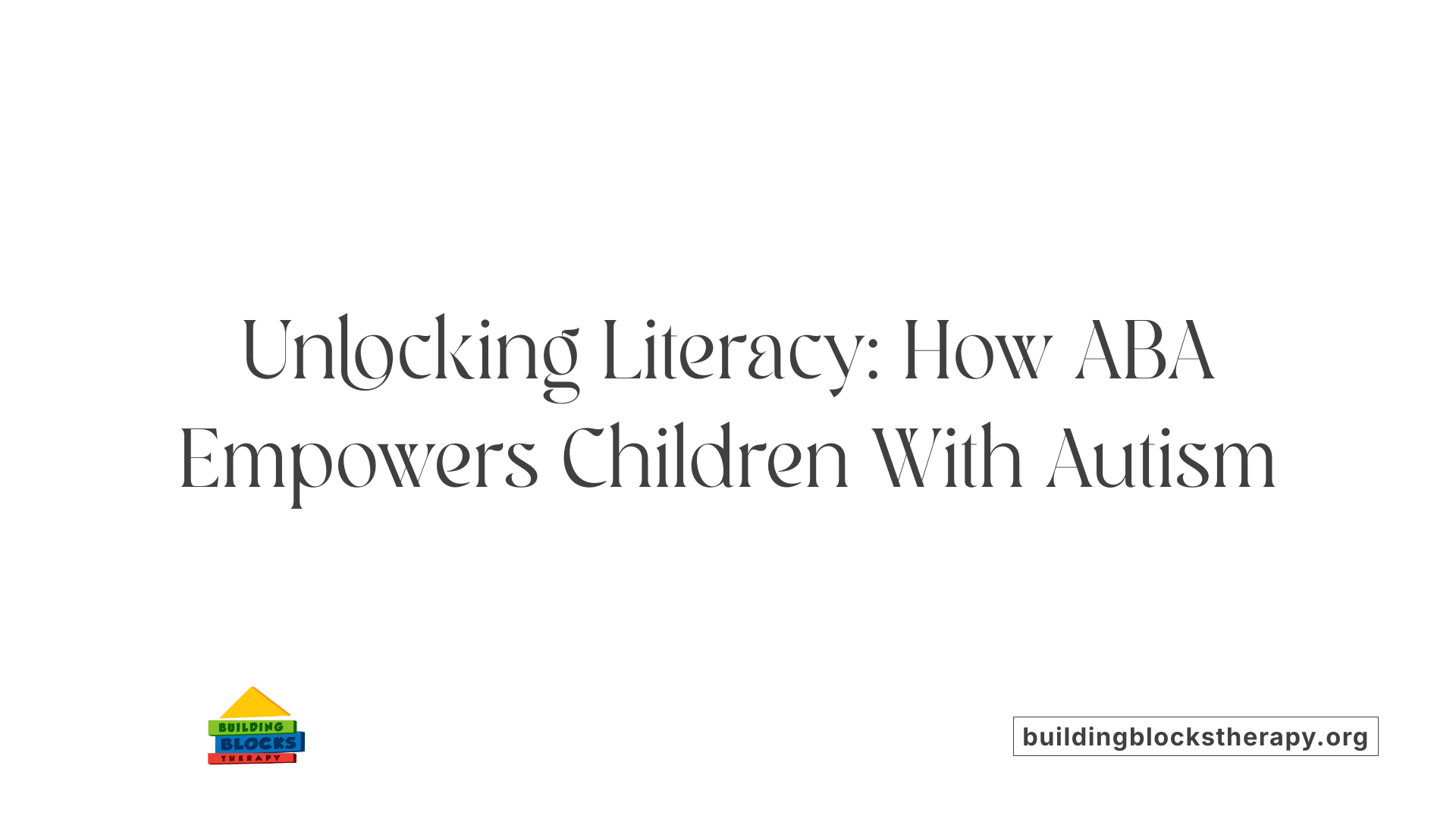Understanding ABA Therapy's Role in Literacy Development
Applied Behavior Analysis (ABA) therapy has emerged as a cornerstone in supporting children with autism to develop vital academic and social skills, especially in the realm of writing and communication. Through structured, individualized interventions, ABA creates an environment where children can enhance their fine motor skills, build confidence, and acquire functional writing abilities. This article explores how ABA therapy leverages evidence-based techniques to nurture literacy, focusing on the methods used, their benefits, and key outcomes.
Core Techniques and Strategies in ABA for Writing Development

What are the key techniques and strategies used in ABA therapy to improve writing abilities and communication?
ABA therapy employs a variety of evidence-based methods to foster writing and communication skills in children with autism. One foundational approach is task analysis, which involves breaking down complex writing tasks into small, manageable steps. For example, a child may first learn to hold a pencil, then progress to tracing letters, and eventually form short words. This gradual sequencing makes learning less overwhelming and builds confidence.
Positive reinforcement is another crucial strategy. Children receive rewards—such as praise, tokens, or preferred activities—when they complete steps or achieve milestones. This motivates continued effort and engagement. Techniques like visual prompts and modeling are used to guide children through tasks. Visual aids—such as pictures, cue cards, or digital tools—help clarify instructions and support independent work.
Behavior analysis plays a vital role by assessing what a child can do and pinpointing areas needing improvement. This personalized insight allows therapists to tailor interventions specifically suited to the child's abilities and learning pace.
How does ABA therapy support the development of writing and communication skills in children with autism?
ABA therapy enhances writing and communication by creating structured learning environments that incorporate visual supports and assistive technology. Visual supports, such as picture schedules and visual cues, help children understand what is expected, reducing confusion and enhancing focus.
Prompting techniques—like verbal prompts, physical guidance, or visual cues—are used to model correct behaviors and help children imitate desired actions. Over time, prompts are systematically faded to promote independence.
Supporting communication also involves teaching children to use augmentative and alternative communication (AAC) devices, such as picture exchange communication systems (PECS) or speech-generating devices. These tools boost expressive language, which is essential for effective writing.
Addressing fine motor skills is part of the therapy. Activities like tracing, puzzles, and occupational therapy exercises improve hand strength and coordination, foundational for handwriting. Additionally, ABA strategies target spelling and grammar by using visual aids (like word walls), providing structured feedback, and utilizing learning apps that reinforce correct spelling patterns.
By breaking down writing into small steps, employing visual and physical prompts, and offering consistent reinforcement, ABA helps children gradually improve their handwriting, spelling, and overall ability to communicate in written form.
Additional Techniques and Support Tools
| Technique | Description | Purpose |
|---|---|---|
| Task Analysis | Breaking tasks into small, teachable steps | Building confidence and managing complexity |
| Visual Supports | Use of pictures, schedules, cue cards | Enhancing understanding and independence |
| Prompting & Modeling | Providing cues or demonstrations | Teaching correct responses and behaviors |
| Reinforcement Systems | Rewards tailored to individual interests | Motivating continued learning |
| Assistive Technology | Digital apps, communication devices | Supporting expressive and receptive skills |
Overall, ABA employs a comprehensive suite of strategies—from task analysis and prompting to positive reinforcement and assistive tools—to support children on the autism spectrum in achieving meaningful progress in writing and communication.
Breaking Down Writing Tasks for Progressive Learning

What is task analysis in ABA therapy and how does it help children with autism improve their writing skills?
Task analysis involves breaking down complex writing tasks into smaller, manageable steps. For children with autism, this approach makes learning less overwhelming and easier to grasp. For example, instead of jumping straight into writing sentences, a therapist might start with simple actions like holding a pencil correctly or tracing basic shapes. By focusing on each small step, children gain a clear understanding of what is expected, which helps build their confidence and encourages gradual progress.
How does incremental learning and small milestones support children’s motivation and success?
Achieving small milestones—like correctly holding a pencil, forming a letter, or writing a short word—gives children a sense of accomplishment. These milestones serve as markers of progress, helping to maintain motivation. As children succeed in each step, they develop patience and persistence, which are crucial for mastering more complex writing skills. Regularly celebrating these small victories boosts their confidence and fosters a positive attitude toward learning.
What are some specific activities used in ABA therapy to develop writing skills?
ABA therapy incorporates various targeted activities to improve writing abilities:
| Activity | Purpose | Additional Details |
|---|---|---|
| Tracing exercises | Improve fine motor skills and letter recognition | Using worksheets or tactile tools like sandpaper letters |
| Letter formation practice | Teach children to properly shape and write letters | Repetition with visual prompts and verbal cues |
| Sentence construction tasks | Develop ability to organize thoughts and form sentences | Building from copying simple sentences to writing original ones |
| Fine motor development exercises | Strengthen hand muscles necessary for writing | Puzzles, using occupational therapy tools, and playing with molding clay |
| Visual supports and assistive technology | Enhance understanding and engagement | Word walls, digital apps, and visual prompts support learning at each step |
What are the benefits of ABA therapy for children with autism in developing writing and communication skills?
ABA therapy offers numerous benefits for children with autism aiming to improve their writing and communication abilities. By using techniques like positive reinforcement, children are motivated to try new tasks and persist through challenges. It improves their ability to initiate conversations, understand social cues, and use alternative communication methods if needed. As therapy progresses, children develop greater expressive language skills, confidence, and independence.
ABA sessions are tailored to each child's unique needs, focusing on specific goals such as increasing speech, understanding social interactions, and applying communication skills across different settings. Consistent data collection ensures progress is monitored, and interventions are adjusted to maximize growth. Overall, ABA provides a structured, supportive environment that encourages children to develop essential literacy and communication skills, setting a foundation for broader academic and social success.
Enhancing Fine Motor and Handwriting Skills

How does ABA therapy support the development of writing and communication skills in children with autism?
ABA therapy plays a vital role in helping children on the autism spectrum improve their writing and communication skills. By developing personalized plans, therapists use visual supports, prompting, and positive reinforcement to keep children motivated and engaged. These strategies help children understand and practice foundational skills such as grasping a pencil, forming letters, and constructing sentences.
To build these skills, ABA employs structured activities like tracing shapes and letters, puzzles that promote fine motor control, and sensory supports that reinforce learning. Consistent routines and visual cues create a predictable environment, reducing anxiety and helping children focus on specific tasks. When combined with occupational therapy tools, ABA can effectively enhance motor control, hand-eye coordination, and overall handwriting ability.
Monitoring progress involves recognizing small achievements, such as correctly forming a letter or holding a pencil properly. These milestones indicate the child's growth and help therapists adjust strategies to maintain momentum. Over time, children gain confidence, independence, and motivation to improve their writing and communication skills.
| Activities for Developing Fine Motor Skills | Exercise Tools & Occupational Therapy Integration | Progress Indicators (e.g., Letter Formation) |
|---|---|---|
| Tracing exercises | Pencils, crayons, tactile shaping tools | Correct letter formation |
| Puzzle games | Occupational therapy putty | Holding a writing instrument correctly |
| Hand strengthening activities | Adaptive writing aids | Ability to write short words |
| Coloring and painting | Sensory integration tools | Use of visual prompts in writing |
Supporting Literacy and Reading through ABA

What are the benefits of ABA therapy for children with autism in developing writing and communication skills?
ABA therapy provides valuable support for children on the autism spectrum in improving their writing and communication abilities. It employs structured, individualized strategies that are tailored to each child's specific needs, helping them develop essential skills in a gradual and confident manner.
One of the primary features of ABA therapy is the use of positive reinforcement techniques. Rewards such as praise, stickers, or preferred activities motivate children to participate actively and persist through learning tasks. This encouragement builds motivation and fosters a positive learning environment.
A significant aspect of ABA is visual supports and assistive technology, which enhance understanding and engagement. Visual aids like picture schedules, alphabet charts, and digital apps clarify instructions and help children process information more effectively.
To tackle common obstacles like fine motor challenges and spelling difficulties, ABA incorporates exercises such as tracing letters, puzzles, and occupational therapy tools. These activities strengthen motor skills crucial for handwriting and improve spelling through visual aids like word walls and interactive apps.
ABA therapy also emphasizes breaking down complex writing tasks into manageable steps via task analysis. For example, children learn how to hold a pencil, form individual letters, then proceed to writing words and sentences. This step-by-step approach builds confidence and organizational skills.
Other techniques like prompting, visual cues, and gradual increase in task difficulty foster independence. For instance, visual prompts encourage correct letter formation, while positive feedback reinforces successful attempts.
Enhancing attention and focus is vital; thus, ABA therapists create structured routines with visual schedules and adjustable difficulty levels. These setups help reduce cognitive overload and maintain engagement.
Research involving 16 children with ASD participating in ABA-based treatment shows promising results. These children demonstrated progress across various domains, including academic, social, and daily living skills. Using systematic data collection, therapists track and tailor interventions, ensuring continuous development.
Overall, ABA’s comprehensive approach—combining task analysis, reinforcement, visual supports, and behavioral strategies—effectively promotes literacy skills, handwriting, and overall communication for children with autism, supporting their academic success and everyday independence.
Fostering Growth Through Tailored ABA Approaches
In summary, ABA therapy employs a comprehensive suite of strategies rooted in evidence-based practices to support children with autism in developing essential writing and communication skills. By breaking down complex tasks, utilizing visual supports, reinforcing positive behaviors, and customizing interventions, ABA nurtures confidence, independence, and academic success. Early and consistent application of these techniques has demonstrated significant progress, not only in the realm of literacy but across broader social and behavioral domains. As research continues to validate ABA's effectiveness, it remains an invaluable tool for empowering children with autism to achieve their full potential in literacy and beyond.
References
- Does ABA Therapy Help Improve Writing Skills?
- Why ABA Therapy Matters for Literacy Growth - Behavioral Initiatives
- Does ABA Help with Writing Skills? How Behavior Therapy Supports ...
- Can ABA Improve Handwriting for Kids with Autism?
- Applied behavioral analysis for the skill performance of children with ...
- Applied Behavior Analysis (ABA) | Autism Speaks
- Applied Behavioral Analysis (ABA) - Autism Speaks
- ABA and other therapies | Autism Speaks
- Can ABA help a teen on the mildly affected end of the autism ...
- Expert Q&A: How ABA therapy can help with severe behaviors






